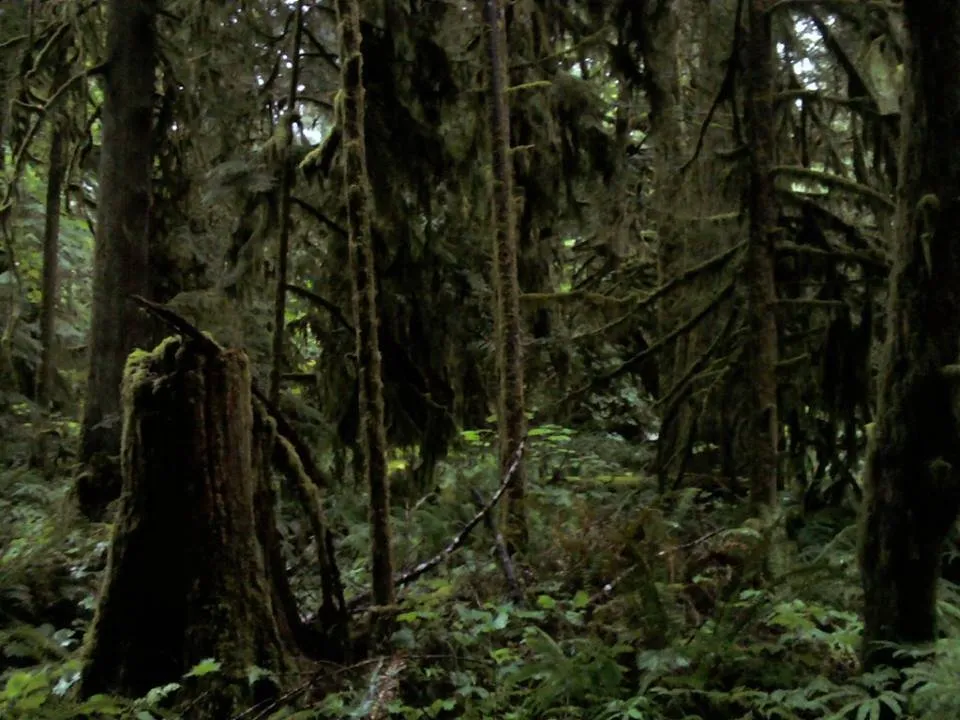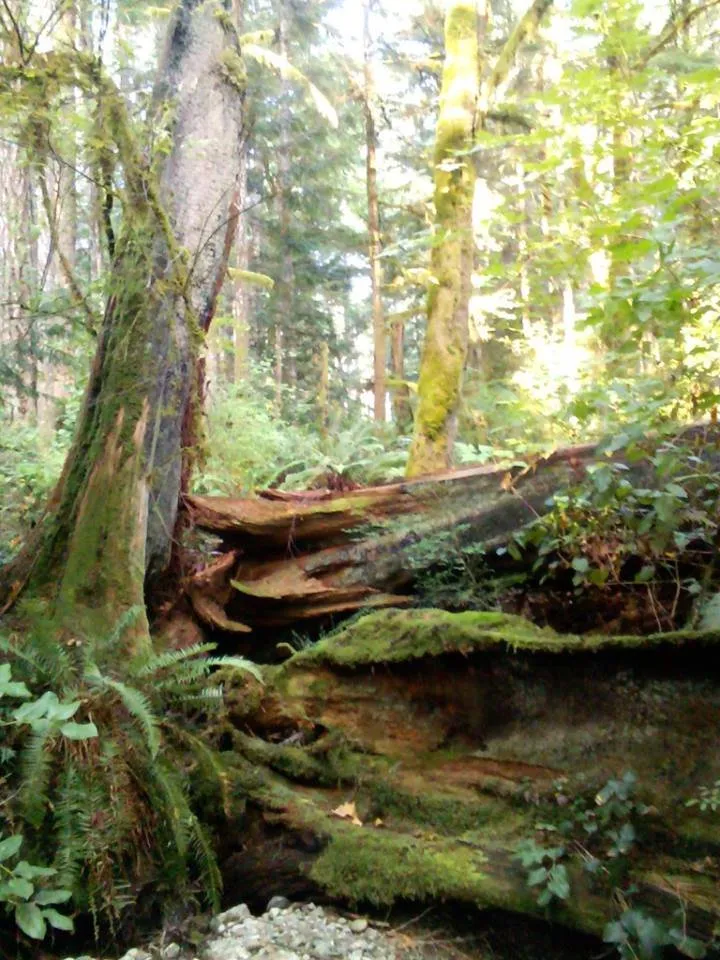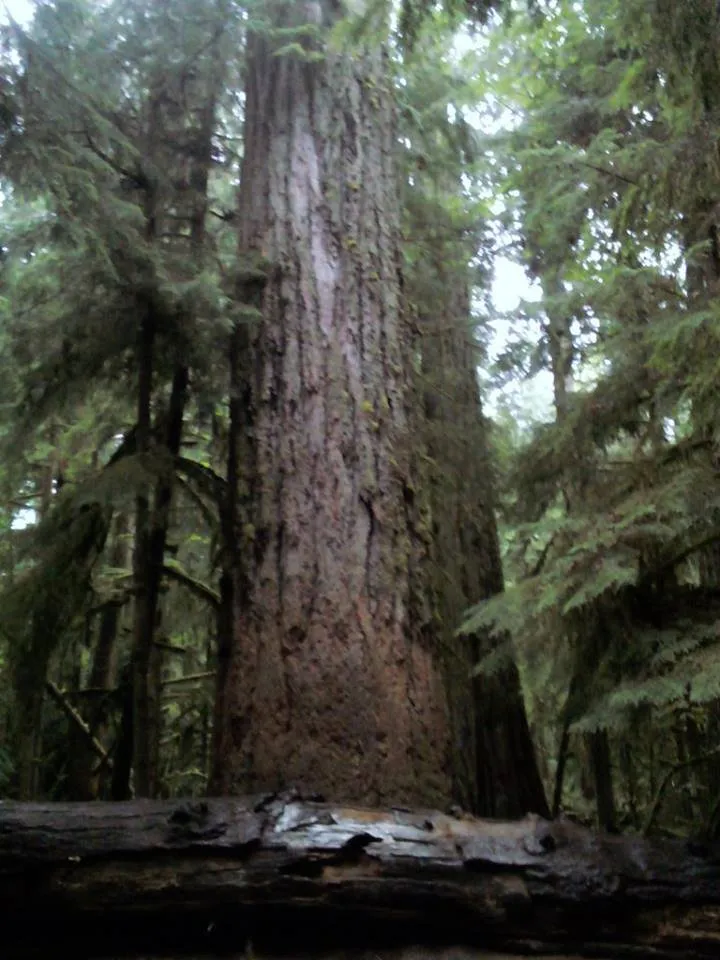How I Came to Collect Tree Branches
After having so much fun with the tree guessing challenge, I decided to write a bit about Vancouver Island, and how I got to explore its gorgeous green residents.
It was about a year ago that I accepted an invitation of my friend Tony to visit him on his newly acquired property, somewhere between Nanaimo and Courtenay on Vancouver Island. We knew each other from the Earthship Academy we'd attended together two years before, and building an earthship is also his final objective. Before we could even start thinking about tires, however, there was a lot of preparation to be done. Clearing an area for the construction was among the main ones, as the entire property has not been logged for over 80 years, and is thus populated by dense forest. Not any kind of forest either: firs and cedars, hemlocks and pines, towering over each other, as one would rightfully assume in this bioregion.

Valuing his trees, Tony doesn't just want to get rid of them, he wants to make the most out of them. And since many of them make excellent construction material, he even wants to modify the earthship to use timber in place of concrete wherever possible. Transporting the trunks to a sawmill after clearing the land, having them milled, and then returned to the property would cost so much effort, energy, not to mention money, that it wouldn't be worth it. So, the solution he came up with was to mill them right on site, with a mobile sawmill.
Now, about the sawmill and the trip in general I want to write separately, as I believe they are interesting enough to fill complete articles. Instead, I would like to immerse myself in the world of these wonderful green giants I got to knowing and loving.
Western Red Cedar – A Tree Well Suited for the Rainy Climate
The first tree that I learned to identify was of course the cedar, more specifically the Western Red Cedar and Yellow Cedar. The distinct looking bark, the upward curling branches, and especially the leaves (not really needles, but also far from your typical leaf) leave no doubt about what kind of tree it is. I'd known cedar by its name, and I was familiar with the lovely color and smell of its wood. Also, in the Earthship Acadamy we learned that for framing under the greenhouse windows they recommend cedar, as it is less affected by water. But on Tony's site I got to know many other interesting properties of this wonderful tree.

First and foremost, cedar just doesn't seem to want to rot. Okay, that's not true! With time it will decompose, as it can be seen on so many fallen trees all over the woods. Usually you can even see another tree or berry bush growing out from it, making the dead stump a nursing log. But it all takes a long time, even in this wet and fungus rich environment. So it is safe to use the wood for fences, shingles, or any outside application. That's because cedar is full of preserving oils, responsible for the lovely smell, as well as for making it an excellent fuel. And true to that, starting a fire with just a few slivers of cedar wood has never been easier. Of course nobody knows the full range of practical uses of the cedar tree better than the local native peoples. Especially the bark can be turned into aesthetic and functional clothing, as well as baskets, purses, and other accessories.
Douglas Fir – The Tallest Fir Is Not a Fir
The other famous tree I encountered is the Douglas Fir, with it's record-breaking size of 90 meters (300 ft) or more, if given the chance to reach that height in about a millennium. One distinguishing characteristic is its spiral pattern of branches and needles, making it look like a big bottle brush. It's named after botanist David Douglas all right, but the Fir part is a misnomer. It's not even related to fir trees! Instead it's in the genus Pseudotsuga, with tsuga being the Japanese term for Hemlock, and pseudo just meaning that it has equally nothing to do with it. However, the property and the surrounding woods have lots of actual hemlocks and firs, more precisely the Grand Fir and the Western Hemlock are well represented. That's great news for construction, as hemlocks and firs (real and pseudo) make good structural timber.

Hemlock – The Real Tsuga
Hemlocks can be easily recognized by their shaggy looks, like a head in need of a good combing, and their unique looking needle branches. They are, by the way, not the plant that was given to Socrates, though it bears the same name. The word Tsuga, on the other hand, supposedly means 'mother tree' in Japanese, according to the tree book I'm using to get to know these woods. I have no doubts about it, even though the words I learned are oka(san) for mother, and moku for tree. But I know that words tend to have many meanings, and ideas have many words to describe them, which is especially true when it comes to plants and animals. So instead of losing myself in semantics, let me move on to my favorite tree, the Sitka Spruce.
Sitka Spruce – The Elusive Pokemon
The most well known feature of this tree are its hard needles, making it quite painful to touch. But how did it become my all time favorite one? It was probably the challenge of finding it. As I went on my morning walks, the tree book in my pocket, looking at the various types of conifers, I took a small branch sample of each type. Most of them I managed to identify quickly, others were a bit trickier, but pretty soon I reached a point where I was just about to catch them all... Some I'd have to exclude from my search, as they didn't occur on the island according to the book, or at least in our area, according to the locals.
Of course there is always one Pokemon that you know is out there, but still not in your pocket yet. On a hiking trail just behind the property a sign informed hikers about the Sitka, including how to recognize it by its flaky bark. And sure enough, a few of them were standing around with this distinct feature. So close, only that their branches were at least 50 meters above me. The sheer presence of these big ones wouldn't let me rest without having a prickly little branch of Sitka poking through my pockets. I just had to find some smaller trees, which was quite unlikely in the dense understorey of the trail, or even on the property itself. But where would the younger members of this type of pokemon hang out? Of course along the railroad tracks! It's hard to describe the euphoric joy I felt as the hard needles scraped through my pants, as I was walking back to the property.

Apart from this personal challenge of catching it, the Sitka Spruce has some interesting qualities: It is a very soft wood, making it popular among boat builders and instrument makers. Even more interestingly, its inner bark can be eaten raw, or mixed with berries, according to a First Nation recipe.
Berries – Abundance on the Forest Floor
After talking about the giants, I would feel a little bad if I didn't at least mention the little guys on the forest floor. Mosses and ferns create a picturesque view of an enchanted forests, but there are also many berries that can (and should) be eaten. Some examples are Huckleberries, Salmon Berries, Rose-hips, Oregon Grapes, Native Blackberries, and Salal just to mention the most common ones. The latter one doesn't only offer berries, but the cuttings are well sought after by florists. Finally I should mention the Achlys, whose leaves emit a delicious vanilla-like smell. With so many goodies growing everywhere, one could look at it as money on the ground, only wanting to be picked up.
The photos were taken by me, on the property, as well as in Cathedral Grove, the old-growth museum nearby.
Sources: 1, Pics: original